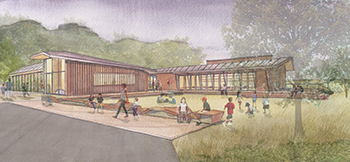 AMHERST, Mass. — The Hitchcock Center for the Environment, located in Amherst, broke ground May 1 on an environmental center designed and constructed to the world’s toughest sustainable development standards.
AMHERST, Mass. — The Hitchcock Center for the Environment, located in Amherst, broke ground May 1 on an environmental center designed and constructed to the world’s toughest sustainable development standards.
The 9,000-square-foot center will be New England’s first public environmental education facility to join the Living Building Challenge. The challenge presents 20 performance standards that require buildings to be self-sufficient for energy and water needs, and meet strict requirements for both green materials use and indoor air quality.
Worldwide, fewer than 10 buildings have been fully certified as living buildings. Speakers at the groundbreaking included Sen. Stanley Rosenberg (D-Amherst); Rep. Ellen Story (D-Amherst); Acting Commissioner Dan Burgess of the Massachusetts Department of Energy Resources; Jonathan Lash, president of Hampshire College; and other community representatives.
Sited on Hampshire College land 2.5 miles from its current location on Route 116, the new center will be situated at the top of a hayfield between Hampshire’s Red Barn and Farm Center with access to miles of trails and a variety of ecological habitats. The building itself is intended to serve as a teaching and learning tool that invites visitors to explore ecological principles throughout the building and landscape.
“We are deeply committed to the philosophy and framework of the challenge as an amplification of our educational mission,” Julie Johnson, executive director of the Hitchcock Center, said in a statement. “The process will transform how we think about design and construction as an opportunity to benefit both the environment and community life.”
Founded in 1962, the Hitchcock Center for the Environment fosters awareness and understanding of the natural environment through programs with a particular focus on educating children. Currently based in a rustic carriage house located on the Larch Hill Conservation Area in Amherst, the existing facility cannot be expanded due to wetlands and other site constraints, yet the number of participants in educational programs has more than doubled in the past decade.
To keep pace with current and future demand, the new living building and its landscapes will allow Hitchcock to strengthen existing programs while creating new ones to meet complex environmental challenges. By 2020, annual program participation is estimated to grow from 8,500 to 11,500 children, youth and adults through programs geared toward underserved communities, programs focused on the child-nature connection, more in-depth naturalist and citizen science programs, and enhanced K-12 curriculum focused on sustainability.
On April 17, the Hitchcock Center and Hampshire College officially executed a ground lease agreement that secured the Center’s new home for the next 95 years. The Hitchcock Center, which remains independent, plans to complete the new building in time for its fall 2016 programming. A $5.8 million dollar capital campaign will fund the new center. “Building for the Future: a Campaign for the Hitchcock Center” has already raised $4.5 million dollars through lead support from the Kendeda Fund, the Commonwealth of Massachusetts, the Massachusetts Department of Energy Resources, the Massachusetts Cultural Facilities Fund, and local individuals, foundations and businesses. The campaign officially launched on May 1.

